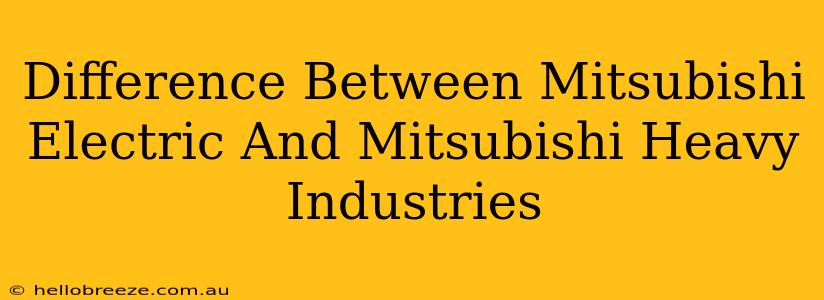Mitsubishi. The name conjures images of cutting-edge technology and reliable performance. But within the Mitsubishi family, there are two distinct giants: Mitsubishi Electric and Mitsubishi Heavy Industries (MHI). While often confused, these companies operate independently, focusing on different sectors of the industry. Understanding their key differences is crucial for anyone navigating the world of Japanese engineering and manufacturing.
Understanding the Lineage: A Shared History, Separate Paths
Both companies trace their roots back to the same founding company, but diverged decades ago. This shared heritage often leads to confusion, but their current operations are vastly different. It's important to note that while they share a common ancestor, they are now entirely separate entities, competing in some areas and collaborating in others.
Mitsubishi Electric: Powering the World
Mitsubishi Electric is a global leader in electrical and electronic equipment. Their vast portfolio includes:
- Home Appliances: From air conditioners and refrigerators to microwaves and washing machines, Mitsubishi Electric offers a wide range of home solutions.
- Industrial Automation: They are a key player in factory automation, providing robotics, control systems, and other essential technologies.
- Power Systems: Mitsubishi Electric is heavily involved in power generation, transmission, and distribution, contributing significantly to global energy infrastructure.
- Semiconductors: A vital component of modern electronics, Mitsubishi Electric's semiconductor production plays a key role in many technological advancements.
- Space Systems: Contributing to space exploration and satellite technology, showcasing their technological expertise.
Mitsubishi Heavy Industries: Engineering on a Grand Scale
Mitsubishi Heavy Industries (MHI) is a diverse industrial conglomerate focusing on large-scale projects and heavy machinery. Their areas of expertise include:
- Aerospace: MHI plays a crucial role in the aerospace industry, contributing to aircraft manufacturing, space exploration, and defense systems.
- Energy: They are involved in the development and implementation of various energy solutions, including nuclear power, renewable energy, and thermal power generation.
- Shipbuilding: A legacy area for MHI, they remain a significant player in the design and construction of large vessels.
- Industrial Machinery: MHI manufactures heavy machinery for various industrial sectors, including construction, mining, and manufacturing.
- Infrastructure: They contribute to large-scale infrastructure projects globally, building bridges, tunnels, and other essential components of modern societies.
Key Differences Summarized
To avoid confusion, here's a quick comparison of the two companies:
| Feature | Mitsubishi Electric | Mitsubishi Heavy Industries |
|---|---|---|
| Primary Focus | Electrical & Electronic Equipment | Heavy Machinery & Large-Scale Projects |
| Product Range | Consumer electronics, industrial automation, power systems | Aerospace, energy, shipbuilding, industrial machinery |
| Market Presence | Broad consumer and industrial markets | Primarily industrial and large-scale projects |
| Scale of Projects | Ranges from small to large | Primarily large-scale, complex projects |
Conclusion: Two Distinct Leaders
While sharing a common ancestor, Mitsubishi Electric and Mitsubishi Heavy Industries are independent entities with distinct focuses and product portfolios. Understanding these differences is crucial for anyone seeking to engage with these industry leaders. Whether you are considering home appliances, industrial automation solutions, or large-scale infrastructure projects, knowing which company to approach will significantly improve your chances of success.

